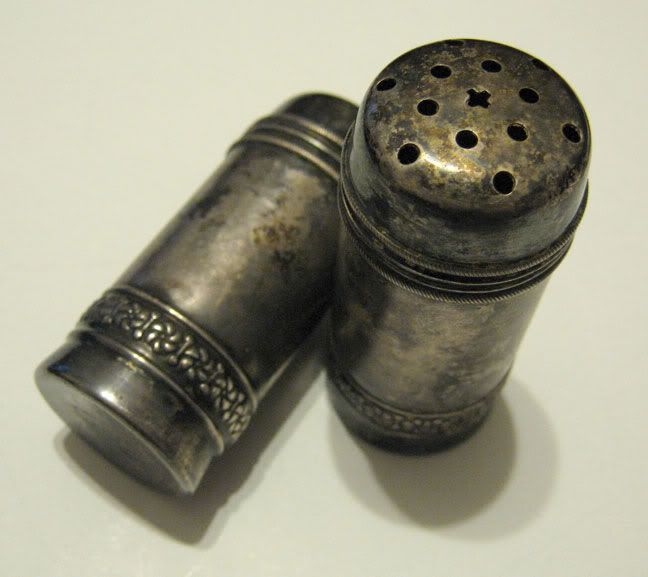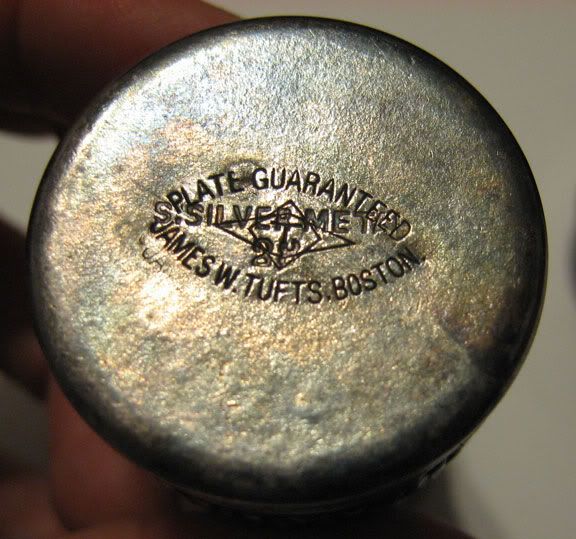PLATE GUARANTEED = Warranty for the Plating
S.SILVER METAL = Solid Silver Metal = “German Silver”, “Nickel Silver” ...
JAMES W. TUFTS.BOSTON. = James W. Tufts, founded around 1875, in Boston/MA
Hello »
Garnet«
1. By more knowledge of company’s history it’s by a historian maybe possible to date more precise. Maybe they've in Boston a industry museum, or archive?
But you must hold in mind, that especially Plated producers haven’t need to register any mark; it was up to them, if they registered their mark or not — well, it was always possible to register a (Trade) mark in America.
Look here for a maybe younger example of »Tufts« mark (right side column, middle): http://www.925-1000.com/silverplate_T.html" onclick="window.open(this.href);return false;
You are maybe wondering, because in your example is around the inner circle with
T a square, as a part of the “
star shape” — the square, which is missing his left and right edges in the other, maybe younger (?) example.
The striker has start to strike the maker’s mark at least twice, before he centred his last strike in about the middle — following by two separately punches:
S.SILVER METAL, and maybe for final the numeral
28.
“Quadruple Plate” = a not by any public agreement defined American “Plated Standard” of highest degree; but on a much lower degree as the usual Standard of 90 gram pure silver on a quarter of a square metre in Continental Europe.
In steps of lowering in quality are: »Triple Plate«, »Double Plate(d)«, and for final the lowest warranty was, be »Plated«; as here is shown by the marking.
These kind of American freedom consequences were for the public, that “Quadruple Plate” warranty of one producer was some times equal as the »Triple Plate« or »Double Plated« warranty of others!
2. »
28« could be indeed a pattern number — but, only “
could be”! It’s necessary to know their product range of hollowware, e.g. to have an illustrated catalogue, or at least a price list …
A European Example: A pioneer company in metal wares, founded 1815, had a sugar case numbered with 12. Around 1848, 1874, 1888, 1902 the »shape« was still in production — but every time with a different “outfit”.
But numerals could be also: badge numbers, contents indication; inventory number of a hotel or restaurant …
I’ve a coffee spoon in my collection — I’ve buy him for reason of his many numeral indications. But now about two decennia later, I haven’t until yet a sounded clue, only a final guess: Out of the sales man sample case?
3. As objects basic materials were in use »Britannia alloy«, a kind of Pewter, »
Nickel Silver«, brass and copper.
In relation to the used basic material were the other costs of production; e.g. necessary quality and durability of dies.
»Britannia alloy« has needed another type of dies (coquilles), as copper, brass, and for final »
Nickel Silver«. Dies for the soft copper were cheaper as they for brass (harder by the alloy partner of zinc). »
Nickel Silver«, with his alloy partner of zinc and the much harder
nickel, has needed a better steel quality and more qualified tool and die maker, for to get an acceptable dies durability.
So in the market, the sales men had to sound their higher sales costs by
warranties for the used, but not visible basic material; in this case:
S.SILVER METAL =
Solid Silver Metal — and for final, a warranty of the plated surface. Please read this (Alpacca):
http://www.925-1000.com/silverglossary.html" onclick="window.open(this.href);return false;
It seems to me, yours Salter and Pepper is out of a range of the so called »Hotel Silver« = Metal wares, made for the »Public use« in Hotels, Restaurants, Bars, Clubs, Cruise ships …
Well, there in the »Hotel Silver« market it was necessary to offer, if possible, some decorative details — but for reason of public hygiene it was very important to could easy clean the items.
I hope that my broad expanded explanations help you in yours own research, and final clues as well.
Kind regards silverport



